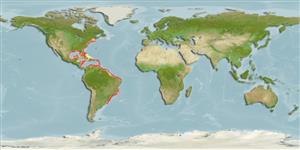Environment: milieu / climate zone / depth range / distribution range
Ökologie
seewasser demersal; tiefenbereich 50 - 500 m (Ref. 26999), usually 100 - 200 m (Ref. 26999). Subtropical; 45°N - 35°S, 98°W - 34°W
Western Atlantic: Canada (Ref. 5951) to Maine, USA and northern Gulf of Mexico to Uruguay. Eastern Atlantic: Senegal to Angola (Ref. 5512).
Length at first maturity / Size / Gewicht / Alter
Maturity: Lm 10.0 range ? - ? cm
Max length : 30.0 cm TL Männchen/unbestimmt; (Ref. 7251); common length : 23.0 cm FL Männchen/unbestimmt; (Ref. 47377)
Rückenflossenstacheln (insgesamt) : 12; Rückenflossenweichstrahlen (insgesamt) : 13 - 16; Afterflossenstacheln: 3; Afterflossenweichstrahlen: 15.
Occurs chiefly on the continental shelf, mostly on muddy bottoms (Ref. 2683). Juveniles occur in surface waters. Feeds mainly on small crustaceans. Forms large schools (Ref. 36543). Adults are demersal or bathypelagic (Ref. 47377).
Oviparous, gonochorous, with pelagic eggs (Ref. 101194).
Robins, C.R. and G.C. Ray, 1986. A field guide to Atlantic coast fishes of North America. Houghton Mifflin Company, Boston, U.S.A. 354 p. (Ref. 7251)
IUCN Rote Liste Status (Ref. 130435: Version 2024-1)
Bedrohung für Menschen
Harmless
Nutzung durch Menschen
Fischereien: weniger kommerziell
Tools
Zusatzinformationen
Download XML
Internet Quellen
Estimates based on models
Preferred temperature (Ref.
123201): 13 - 23.8, mean 19 °C (based on 119 cells).
Phylogenetic diversity index (Ref.
82804): PD
50 = 0.5156 [Uniqueness, from 0.5 = low to 2.0 = high].
Bayesian length-weight: a=0.01380 (0.00982 - 0.01940), b=2.93 (2.84 - 3.02), in cm total length, based on LWR estimates for this species (Ref.
93245).
Trophic level (Ref.
69278): 3.5 ±0.50 se; based on food items.
Widerstandsfähigkeit (Ref.
120179): hoch, Verdopplung der Population dauert weniger als 15 Monate. (Preliminary K or Fecundity.).
Fishing Vulnerability (Ref.
59153): Low vulnerability (20 of 100).
Nutrients (Ref.
124155): Calcium = 116 [65, 221] mg/100g; Iron = 1.35 [0.82, 2.33] mg/100g; Protein = 20.8 [18.8, 22.5] %; Omega3 = 0.484 [0.301, 0.780] g/100g; Selenium = 39.2 [19.5, 72.1] μg/100g; VitaminA = 9.17 [3.11, 27.94] μg/100g; Zinc = 0.738 [0.524, 1.075] mg/100g (wet weight); based on
nutrient studies.
